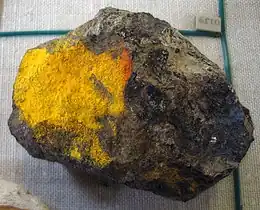Hawleyite
Hawleyite is a rare sulfide mineral in the sphalerite group, dimorphous and easily confused with greenockite. Chemically, it is cadmium sulfide, and occurs as a bright yellow coating on sphalerite or siderite in vugs, deposited by meteoric water.[4]
| Hawleyite | |
|---|---|
 Orange-yellow earthy coating | |
| General | |
| Category | Sulfide mineral |
| Formula (repeating unit) | CdS |
| IMA symbol | Hwl[1] |
| Strunz classification | 2.CB.05a |
| Crystal system | Cubic |
| Crystal class | Hextetrahedral (43m) H-M symbol: (4 3m) |
| Space group | F43m |
| Unit cell | a = 5.818 Å; Z = 4 |
| Structure | |
| Jmol (3D) | Interactive image |
| Identification | |
| Color | Bright yellow |
| Crystal habit | Powdery massive |
| Mohs scale hardness | 2.5-3 |
| Luster | Metallic |
| Streak | Light yellow |
| Diaphaneity | Translucent to opaque |
| Specific gravity | 4.87 |
| References | [2][3][4] |

Structure of Hawleyite
It was discovered in 1955 in the Hector-Calumet mine, Keno-Galena Hill area, Yukon Territory and named in honour of mineralogist James Edwin Hawley (1897–1965), a professor at Queen's University in Ontario, Canada.[3][2]
References
- Warr, L.N. (2021). "IMA–CNMNC approved mineral symbols". Mineralogical Magazine. 85 (3): 291–320. Bibcode:2021MinM...85..291W. doi:10.1180/mgm.2021.43. S2CID 235729616.
- MinDAT
- Webmineral
- Handbook of Mineralogy
This article is issued from Wikipedia. The text is licensed under Creative Commons - Attribution - Sharealike. Additional terms may apply for the media files.